Camera obscura
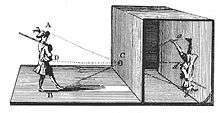

Camera obscura (from Latin "camera": (vaulted) chamber or room, and "obscura": darkened, plural: camerae obscurae), also referred to as pinhole image, is the natural optical phenomenon that occurs when an image of a scene at the other side of a screen (or for instance a wall) is projected through a small hole in that screen as a reversed and inverted image (left to right and upside down) on a surface opposite to the opening. The surroundings of the projected image have to be relatively dark for the image to be clear, so many historical camera obscura experiments were performed in dark rooms.
The term "camera obscura" also refers to constructions or devices that make use of the principle within a box, tent or room. Camerae obscurae with a lens in the opening have been used since the second half of the 16th century and became popular as an aid for drawing and painting. The camera obscura box was developed further into the photographic camera in the first half of the 19th century when camera obscura boxes were used to expose light-sensitive materials to the projected image.
Before the term "camera obscura" was first used in 1604, many other expressions were used including "cubiculum obscurum", "cubiculum tenebricosum", "conclave obscurum" and "locus obscurus".[1]
A camera obscura device without a lens but with a very small hole is sometimes referred to as a "pinhole camera", although this more often refers to simple (home-made) lens-less cameras in which photographic film or photographic paper is used.
Physical explanation
Rays of light travel in straight lines and change when they are reflected and partly absorbed by an object, retaining information about the color and brightness of the surface of that object. Lit objects reflect rays of light in all directions. A small enough opening in a screen only lets through rays that travel directly from different points in the scene on the other side and together form an image of that scene when they are reflected on a surface into the eye of an observer. The human eye itself works much like a camera obscura with an opening (pupil), a biconvex lens and a surface where the image is formed (retina).
Technology

A camera obscura device consists of a box, tent or room with a small hole in one side. Light from an external scene passes through the hole and strikes a surface inside, where the scene is reproduced, inverted (thus upside-down) and reversed (left to right), but with color and perspective preserved. The image can be projected onto paper, and can then be traced to produce a highly accurate representation.
In order to produce a reasonably clear projected image, the aperture has to be about 1/100th the distance to the screen, or less.
Many camerae obscurae use a lens rather than a pinhole (as in a pinhole camera) because it allows a larger aperture, giving a usable brightness while maintaining focus.
As the pinhole is made smaller, the image gets sharper, but the projected image becomes dimmer. With too small a pinhole, however, the sharpness worsens, due to diffraction.
Using mirrors, as in an 18th-century overhead version, it is possible to project a right-side-up image. Another more portable type is a box with an angled mirror projecting onto tracing paper placed on the glass top, the image being upright (but still reversed) as viewed from the back.
History
30.000 BCE to 500 BCE: Possible inspiration for prehistoric art and possible use in religious ceremonies
There are theories that occurrences of camera obscura effects (through tiny holes in tents or in screens of animal hide) inspired paleolithic cave paintings. Distortions in the shapes of animals in many paleolithic cave artworks might be inspired by distortions seen when the surface on which an image was projected was not straight or not in the right angle.[2] It is also suggested that camera obscura projections could have played a role in Neolithic structures.[3][4]
Some ancient sightings of gods and spirits, especially in temple worship, are thought to possibly have been conjured up by means of camera obscura projections.[5][6][7]
500 BCE to 500 CE: Earliest written observations
The earliest extant written record of the camera obscura is to be found in the writings of Mozi (circa 470 BCE-circa 391 BCE), a Han Chinese philosopher and the founder of Mohist School of Logic. Mozi correctly asserted that the camera obscura image is flipped upside down because light travels in straight lines from its source. His disciples developed this into a physics theory of optics.[8][note 1]
The Greek philosopher Aristotle (384-322 BCE), or possibly a follower of his ideas, touched upon the subject in the work Problems - Book XV, asking:
"Why is it that when the sun passes through quadri-laterals, as for instance in wickerwork, it does not produce a figure rectangular in shape but circular?”
and further on:
“Why is it that an eclipse of the sun, if one looks at it through a sieve or through leaves, such as a plane-tree or other broadleaved tree, or if one joins the fingers of one hand over the fingers of the other, the rays are crescent-shaped where they reach the earth? Is it for the same reason as that when light shines through a rectangular peep-hole, it appears circular in the form of a cone?"
Aristotle never found an answer. The mystery was resolved centuries later, when it was concluded that the circular shapes on the ground were camera obscura projections of the sun and thus became crescent-shaped during an eclipse.
Euclid is sometimes reported to have mentioned the camera obscura phenomenon as a demonstration that light travels in straight lines in his very influential Optics (circa 300 BCE).[9] However, in common translations[10] no remarks of anything that resembles camera obscura can be found. Claims could be based on later versions, since Ignazio Danti added a description of camera obscura in his 1573 annotated translation.[11]
In the 4th century, Greek scholar Theon of Alexandria observed that "candlelight passing through a pinhole will create an illuminated spot on a screen that is directly in line with the aperture and the center of the candle."
500 to 1100: Experiments, study of light
In the 6th century, the Byzantine-Greek mathematician and architect Anthemius of Tralles (most famous for designing the Hagia Sophia), used a type of camera obscura in his experiments.[12]
In the 9th century, Al-Kindi (Alkindus) demonstrated that "light from the right side of the flame will pass through the aperture and end up on the left side of the screen, while light from the left side of the flame will pass through the aperture and end up on the right side of the screen."
In the 10th century Yu Chao-Lung supposedly projected images of pagoda models through a small hole onto a screen to study directions and divergence of rays of light.[13]
Arab physicist Ibn al-Haytham (known in the West by the latinised Alhazen) (965–1039) explained in his Book of Optics (circa 1027) that rays of light travel in straight lines and are distinguished by the body that reflected the rays and then wrote:
"Evidence that light and color do not mingle in air or (other) transparent bodies is (found in) the fact that, when several candles are at various distinct locations in the same area, and when they all face a window that opens into a dark recess, and when there is a white wall or (other white) opaque body in the dark recess facing that window, the (individual) lights of those candles appear individually upon that body or wall according to the number of those candles; and each of those lights (spots of light) appears directly opposite one (particular) candle along a straight line passing through that window. Moreover, if one candle is shielded, only the light opposite that candle is extinguished, but if the shielding object is lifted, the light will return."[14]:91#5:p379[6.85],[6.86]
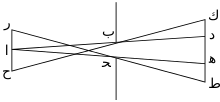
In his 1038 essay "On the form of the Eclipse" (Maqalah-fi-Surat-al-Kosuf) (Arabic: مقالة في صورةالكسوف) he wrote:
"The image of the sun at the time of the eclipse, unless it is total, demonstrates that when its light passes through a narrow, round hole and is cast on a plane opposite to the hole it takes on the form of a moon-sickle. The image of the sun shows this peculiarity only when the hole is very small. When the hole is enlarged, the picture changes, and the change increases with the added width. When the aperture is very wide, the sickle-form image will disappear, and the light will appear round when the hole is round, square if the hole is square, and if the shape of the opening is irregular, the light on the wall will take on this shape, provided that the hole is wide and the plane on which it is thrown is parallel to it."[15]
Al-Haytham also analyzed the rays of sunlight and concluded that they make a conic shape where they meet at the hole, forming another conic shape reverse to the first one from the hole to the opposite wall in the dark room (see illustration). Ibn al-Haytham is reported to have stated about the camera obscura: "We did not invent this".[16] al-Haytam's writings on optics became very influential in Europe through Latin translations since circa 1200. Among the people who he inspired were Witelo, John Peckham, Roger Bacon, Leonardo Da Vinci, René Descartes and Johannes Kepler.[17]
In his 1088 book Dream Pool Essays the Song Dynasty Chinese scientist Shen Kuo (1031–1095) compared the focal point of a concave burning-mirror and the "collecting" hole of camera obscura phenomena to an oar in a rowlock to explain how the images were inverted:
"When a bird flies in the air, its shadow moves along the ground in the same direction. But if its image is collected (shu)(like a belt being tightened) through a small hole in a window, then the shadow moves in the direction opposite of that of the bird.[...] This is the same principle as the burning-mirror. Such a mirror has a concave surface, and reflects a finger to give an upright image if the object is very near, but if the finger moves farther and farther away it reaches a point where the image disappears and after that the image appears inverted. Thus the point where the image disappears is like the pinhole of the window. So also the oar is fixed at the rowlock somewhere at its middle part, constituting, when it is moved, a sort of 'waist' and the handle of the oar is always in the position inverse to the end (which is in the water)."
Shen Kuo also responded to a statement of Duan Chengshi in Miscellaneous Morsels from Youyang written in about 840 that the inverted image of a Chinese pagoda tower beside a seashore, was inverted because it was reflected by the sea: "This is nonsense. It is a normal principle that the image is inverted after passing through the small hole."[18]
1100 to 1400: Optical and astronomical tool, entertainment
English statesman and scholastic philosopher Robert Grosseteste (c. 1175 – 9 October 1253) commented on the camera obscura.[19]
_roger_bacon_-_image006.jpg)
English philosopher and Franciscan friar Roger Bacon (c. 1219/20 – c. 1292) tried to answer Aristotle's question (see above), but falsely argued that light travels in spherical waves and therefore assumed its natural shape after passing through square holes. He also advised to study solar eclipses safely by observing the rays passing through some round hole and studying the spot of light they form on a surface.[20] Bacon wrote about optics in his work Opus Majus Part five De Scientia Perspectivae (1267) for which he seems to have studied the writings of Al-Kindi and Al-Haytam. Bacon is sometimes thought to have used a camera obscura projection in combination with mirrors, based on a passage in his book which says (translated from Latin):
"Mirrors may be so arranged that we may see whatever we choose and anything in the house or in the street, and everyone looking at those things will see them as if they were real, but when they go to the spot they will find nothing. For the mirrors can be hidden from things in such a way that the images will be in the open and will appear in the air at the intersection of the visual rays and the catheti (perpendicular plane), and therefore those looking at them would run up to the places where they appear and would judge that the objects are there when there is in reality nothing except an image."
Others point out this contains no evidence of camera obscura and think this possibly alludes to projection with concave mirrors.[21]
A picture of a three-tiered camera obscura (see illustration) is attributed to Bacon, but its origins are not further defined.[22] A very similar picture illustrates pages 129 and 130 of the 1646 edition of Athanasius Kircher's Ars Magna Lucis et Umbrae.[23]
Polish friar, theologian, physicist, mathematician and natural philosopher Erazmus Ciołek Witelo (also known as Vitello Thuringopolonis and by many different spellings of the name "Witelo") wrote about the camera obscura in his very influential treatise Perspectiva (circa 1270-1278), which was largely based on Ibn al-Haytham's work.
English archbishop and scholar John Peckham (circa 1230 – 1292) wrote about the camera obscura in his Tractatus de Perspectiva (circa 1269-1277) and Perspectiva communis (circa 1277-79), falsely arguing that light gradually forms the circular shape after passing through the aperture.[24] His writings were influenced by Roger Bacon.
At the end of the 13th century, Arnaldus de Villa Nova is credited with using a camera obscura to project live performances for entertainment.[25][26]
French astronomer Guillaume de Saint-Cloud suggested in his 1292 work Almanach Planetarum that the eccentricity of the sun could be determined with the camera obscura from the inverse proportion between the distances and the apparent solar diameters at apogee and perigee.[27]
Kamāl al-Dīn al-Fārisī (1267–1319) described in his 1309 work Kitab Tanqih al-Manazir (The Revision of the Optics) how he experimented with a glass sphere filled with water in a camera obscura with a controlled aperture and found that the colors of the rainbow are phenomena of the decomposition of light.[28][29]
French Jewish philosopher, mathematician, physicist and astronomer/astrologer Levi ben Gershon (1288–1344) (also known as Gersonides or Leo de Balneolis) made several astronomical observations using a camera obscura with a Jacob's staff, describing methods to measure the angular diameters of the sun, the moon and the bright planets Venus and Jupiter. He determined the eccentricity of the sun based on his observations of the summer and winter solstices in 1334. Levi also noted how the size of the aperture determined the size of the projected image. He wrote about his findings in Hebrew in his treatise Sefer Milhamot Ha-Shem (The Wars of the Lord) Book V Chapters 5 and 9.[30]
1450 to 1600: Gnomon, earliest depiction, lenses, drawing aid, mirrors
Italian astronomer, mathematician and cosmographer Paolo Toscanelli is associated with the 1475 placement of a bronze plate with a round hole in the dome of the Cathedral of Santa Maria del Fiore in Florence to project an image of the sun on the cathedral's floor. With markings on the floor it functions as a gnomon that tells the exact time of each midday (reportedly to within half a second) as well as the date of the summer solstice. Italian mathematician, engineer, astronomer and geographer Leonardo Ximenes reconstructed the gnomon according to his new measurements in 1756.[31]
_0071-q75-644x596.jpg)
Italian polymath Leonardo da Vinci (1452–1519), familiar with the work of Alhazen in Latin translation and after an extensive study of optics and human vision, wrote the oldest known clear description of the camera obscura in mirror writing in a notebook in 1502, later published in the collection Codex Atlanticus (translated from Latin):
If the facade of a building, or a place, or a landscape is illuminated by the sun and a small hole is drilled in the wall of a room in a building facing this, which is not directly lighted by the sun, then all objects illuminated by the sun will send their images through this aperture and will appear, upside down, on the wall facing the hole.You will catch these pictures on a piece of white paper, which placed vertically in the room not far from that opening, and you will see all the above-mentioned objects on this paper in their natural shapes or colors, but they will appear smaller and upside down, on account of crossing of the rays at that aperture. If these pictures originate from a place which is illuminated by the sun, they will appear colored on the paper exactly as they are. The paper should be very thin and must be viewed from the back.[33]
These descriptions, however, would remain unknown until Venturi deciphered and published them in 1797.[34] Da Vinci also drew 270 diagrams of the camera obscura in his notebooks.[35]
The camera obscura's potential as a drawing aid may have been familiar to artists by as early as the 15th century.

The oldest known published drawing of a camera obscura is found in Dutch physician, mathematician and instrument maker Gemma Frisius’ 1545 book De Radio Astronomica et Geometrica, in which he described and illustrated how he used the camera obscura to study the solar eclipse of January 24, 1544[34]
Italian polymath Gerolamo Cardano described using a biconvex lens in a camera obscura in his 1550 book De subtilitate, vol. I, Libri I-VII,[36]
Sicilian mathematician and astronomer Francesco Maurolico (1494-1575) answered Aristotle's problem how sunlight that shines through rectangular holes can form round spots of light or crescent-shaped spots during an eclipse in his treatise Photismi de lumine et umbra (1521-1554). However this wasn't published before 1611,[37] after Johannes Kepler had published similar findings of his own.
Italian polymath Giambattista della Porta described the camera obscura, which he called "obscurum cubiculum", in the 1558 first edition of his book series Magia Naturalis. He suggested to use a convex mirror to project the image onto paper and to use this as a drawing aid. Della Porta compared the human eye to the camera obscura: "For the image is let into the eye through the eyeball just as here through the window". The popularity of Della Porta's books helped spread knowledge of the camera obscura.[38][39]
In his 1567 work La Pratica della Perspettiva Venetian nobleman Daniello Barbaro (1513-1570) described using a camera obscura with a biconvex lens as a drawing aid.[36]
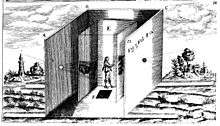
In his influential and meticulously annotated Latin edition of the works of Al-Haytam and Witelo Opticae thesauru (1572) German mathematician Friedrich Risner proposed a portable camera obscura drawing aid; a lightweight wooden hut with lenses in each of its four walls that would project images of the surroundings on a paper cube in the middle. The construction could be carried on two wooden poles.[40] A very similar setup was illustrated in 1645 in Athanasius Kircher's influential book Ars Magna Lucis Et Umbrae.[41]
Around 1575 Italian Dominican priest, mathematician, astronomer, and cosmographer Ignazio Danti designed a camera obscura gnomom and a meridian line for the Basilica of Santa Maria Novella, Florence and he later had a massive gnomon built in the San Petronio church in Bologna. The gnomon was used to study the movements of the sun during the year and helped in determining the new Gregorian calendar for which Danti took place in the commission appointed by Pope Gregorius XIII and instituted in 1582.[42]
In his 1585 book Diversarum Speculationum Mathematicarum[43] Venetian mathematician Giambattista Benedetti proposed to use a mirror in a 45 degree angle to project the image upright. This leaves the image reversed, but would become common practice in later camera obscura boxes.[36]
Giambattista della Porta added a “lenticular crystal” or biconvex lens to the camera obscura description in the 1589 second edition of Magia Naturalis. He also imagined use of the camera obscura to project hunting scenes, battles, games or anything desired. Real or artificial forests, rivers, mountains as well as animals could be used for scenes on an outside stage and projected into a dark room with spectators.[38][44][45]
1600 to 1650: Name coined, camera obscura telescopy, portable drawing aid in tents and boxes
.jpg)
The oldest use of the term "camera obscura" is found in the 1604 book Ad Vitellionem Paralipomena by German mathematician, astronomer, and astrologer Johannes Kepler.[46] Kepler discovered the working of the camera obscura by recreating its principle with a book replacing a shining body and sending threads from its edges through a many-cornered aperture in a table onto the floor where the threads recreated the shape of the book. He also realized that images are "painted" inverted and reversed on the retina of the eye and figured that this is somehow corrected by the brain.[47] In 1607 Kepler studied the sun in his camera obscura and noticed a sunspot, but he thought it was Mercury transiting the sun.[48] In his 1611 book Dioptrice Kepler described how the projected image of the camera obscura can be improved and reverted with a lens. It is believed he later used a telescope with three lenses to revert the image in the camera obscura.[36]
In 1611 Frisian/German astronomers David and Johannes Fabricius (father and son) studied sunspots with a camera obscura, after realizing looking at the sun directly with the telescope could damage their eyes.[48] They are thought to have combined the telescope and the camera obscura into camera obscura telescopy.
In 1612 Italian mathematician Benedetto Castelli wrote to his mentor, the Italian astronomer, physicist, engineer, philosopher and mathematician Galileo Galilei about projecting images of the sun through a telescope (invented in 1608) to study the recently discovered sunspots. Galilei wrote about Castelli's technique to the German Jesuit priest, physicist and astronomer Christoph Scheiner.[49]
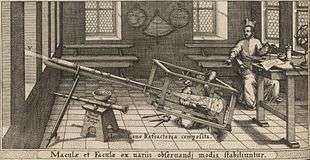
From 1612 to at least 1630 Christoph Scheiner would keep on studying sunspots and constructing new telescopic solar projection systems. He called these "Heliotropii Telioscopici", later contracted to helioscope.[49] For his helioscope studies Scheiner built a box around the viewing/projecting end of the telescope, which can be seen as the oldest known version of a box-type camera obscura. Scheiner also made a portable camera obscura.[50]
In his 1613 book Opticorum Libri Sex[51] Belgian Jesuit mathematician, physicist and architect François d'Aguilon described how some charlatans cheated people out of their money by claiming they knew necromancy and would raise the specters of the devil from hell to show them to the audience inside a dark room. The image of an assistant with a devil's mask was projected through a lens into the dark room, scaring the uneducated spectators.[20]
_Quarteley_(g)_-_Cours_de_Physique_(A._Ganot).jpg)
By 1620 Kepler used a portable camera obscura tent with a modified telescope to draw landscapes. It could be turned around to capture the surroundings in parts.[52]
Dutch inventor Cornelis Drebbel is thought to have constructed a box-type camera obscura which corrected the inversion of the projected image. In 1622 he sold one to the Dutch poet, composer and diplomat Constantijn Huygens who used it to paint and recommended it to his artist friends.[40] Huygens wrote to his parents (translated from French):
I have at home Drebbel's other instrument, which certainly makes admirable effects in painting from reflection in a dark room; it is not possible for me to reveal the beauty to you in words; all painting is dead by comparison, for here is life itself or something more elevated if one could articulate it. The figure and the contour and the movements come together naturally therein and in a grandly pleasing fashion.[53]
.jpg)
German Orientalist, mathematician, inventor, poet, and librarian Daniel Schwenter wrote in his 1636 book Deliciae Physico-Mathematicae about an instrument that a man from Pappenheim had shown him, which enabled movement of a lens to project more from a scene through the camera obscura. It consisted of a ball as big as a fist, through which a hole (AB) was made with a lens attached on one side (B). This ball was placed inside two halves of part of a hollow ball that were then glued together (CD), in which it could be turned around. This device was attached to a wall of the camera obscura (EF).[54] This universal joint mechanism was later called a scioptric ball.
In his 1637 book Dioptrique French philosopher, mathematician and scientist René Descartes suggested placing an eye of a recently dead man (or if a dead man was unavailable, the eye of an ox) into an opening in a darkened room and scraping away the flesh at the back until one could see the inverted image formed on the retina.[55]

Italian Jesuit philosopher, mathematician and astronomer Mario Bettini wrote about making a camera obscura with twelve holes in his Apiaria universae philosophiae mathematicae (1642). When a foot soldier would stand in front of the camera, a twelve person army of soldiers making the same movements would be projected.
French mathematician, Minim friar, and painter of anamorphic art Jean-François Nicéron (1613-1646) wrote about the camera obscura with convex lenses. He explained how the camera obscura could be used by painters to achieve perfect perspective in their work. He also complained how charlatans abused the camera obscura to fool witless spectators and make them believe that the projections were magic or occult science. These writings were published in a posthumous version of La Perspective Curieuse (1652).[56]
1650 to 1800: Introduction of the magic lantern, popular portable box-type drawing aid, painting aid
German Jesuit scientist Gaspar Schott heard from a traveler about a small camera obscura device he had seen in Spain, which one could carry under one arm and could be hidden under a coat. He then constructed his own sliding box camera obscura, which could focus by sliding a wooden box part fitted inside another wooden box part. He wrote about this in his 1657 Magia universalis naturæ et artis (volume 1 - book 4 "Magia Optica" pages 199-201).
By 1659 the magic lantern was introduced and partly replaced the camera obscura as a projection device, while the camera obscura mostly remained popular as a drawing aid. The magic lantern can be seen as a development of the (box-type) camera obscura device.
The 17th century Dutch Masters, such as Johannes Vermeer, were known for their magnificent attention to detail. It has been widely speculated that they made use of camerae obscurae, but the extent of their use by artists at this period remains a matter of considerable controversy, recently revived by the Hockney–Falco thesis.[40]
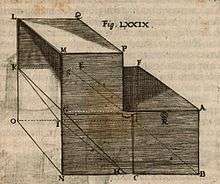
German philosopher Johann Sturm published an illustrated article about the construction of a portable camera obscura box with a 45° mirror and an oiled paper screen in his book Collegium experimentale: sive curiosum (1676).[57]
Johann Zahn's Oculus Artificialis Teledioptricus Sive Telescopium, published in 1685, contains many descriptions, diagrams, illustrations and sketches of both the camera obscura and the magic lantern. A hand-held device with a mirror reflex mechanism was first proposed by Johann Zahn in 1685, a design that would later be used in photographic cameras.[58]
The scientist Robert Hooke presented a paper in 1694 to the Royal Society, in which he described a portable camera obscura. It was a cone-shaped box which fit onto the head and shoulders of its user.[59]
From the beginning of the 18th century craftsmen and opticians would make camera obscura devices in the shape of books, which were much appreciated by lovers of optical devices.[20]
One chapter in the Conte Algarotti's Saggio sopra Pittura (1764) is dedicated to the use of a camera ottica ("optic chamber") in painting.[60]
By the 18th century, following developments by Robert Boyle and Robert Hooke, more easily portable models in boxes became available. These were extensively used by amateur artists while on their travels, but they were also employed by professionals, including Paul Sandby, Canaletto and Joshua Reynolds, whose camera (disguised as a book) is now in the Science Museum in London. Such cameras were later adapted by Joseph Nicephore Niepce, Louis Daguerre and William Fox Talbot for creating the first photographs.
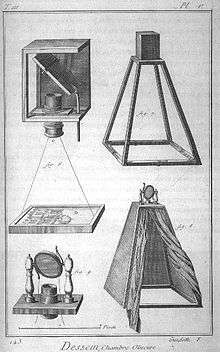
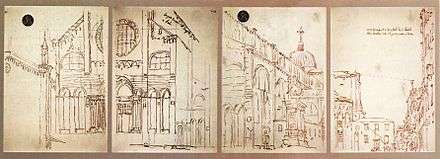
Role in the modern age
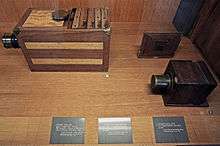
While the technical principles of the camera obscura have been known since antiquity, the broad use of the technical concept in producing images with a linear perspective in paintings, maps, theatre setups and architectural and later photographic images and movies started in the Western Renaissance and the scientific revolution. While e.g. Alhazen (Ibn al-Haytham) had already observed an optical effect and developed a state of the art theory of the refraction of light, he was less interested to produce images with it (compare Hans Belting 2005); the society he lived in was even hostile (compare Aniconism in Islam) towards personal images.[61] Western artists and philosophers used the Arab findings in new frameworks of epistemic relevance.[62] E.g. Leonardo da Vinci used the camera obscura as a model of the eye, René Descartes for eye and mind and John Locke started to use the camera obscura as a metaphor of human understanding per se.[63] The modern use of the camera obscura as an epistemic machine had important side effects for science.[64][65]
Examples
-
A freestanding room-sized camera obscura at the University of North Carolina at Chapel Hill. A pinhole can be seen to the left of the door.
-

A freestanding room-sized camera obscura in the shape of a camera. Cliff House, San Francisco
-
Image of the South Downs of Sussex in the camera obscura of Foredown Tower, Portslade, England
-
A camera obscura created by Mark Ellis in the style of an Adirondack mountain cabin, Lake Flower, Saranac Lake, NY
-
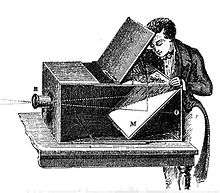
A 19th-century artist using a camera obscura to outline his subject
-
A modern-day camera obscura
-
A modern-day camera obscura used indoors
Public access
| Name | City or Town | Country | Comment | WWW Links |
|---|---|---|---|---|
| Astronomy Centre | Todmorden | England | 80 inches (200 cm) table, 40° field of view, horizontal rotation 360°, vertical adjustment ±15° | Equipment on site#Camera obscura |
| Bristol Observatory | Bristol | England | View of Clifton Suspension Bridge | Clifton Observatory |
| Constitution Hill | Aberystwyth | Wales | 14 inches (360 mm) lens, which is claimed to be the largest in the world | Cliff Railway and Camera Obscura, Aberystwyth |
| Camera Obscura, and World of Illusions | Edinburgh | Scotland | Top of Royal Mile, just below Edinburgh Castle. Fine views of the city | Edinburgh's Camera Obscura |
| Camera Obscura and museum "Prehistory of Film" | Mülheim | Germany | Claimed to be the biggest “walk-in” Camera Obscura in the world. Installed in Broich Watertower in 1992 | http://www.camera-obscura-muelheim.de/cms/the_camera.html |
| Dumfries Museum | Dumfries | Scotland | In Dumfries Castle. Claims to be oldest working example in the world | Dumfries Museum |
| Grand Union Camera Obscura | Douglas | Isle of Man | On Douglas Head. Unique Victorian tourist attraction with eleven lenses | Visit Isle of Man |
| Camera Obscura (Giant Camera) | Golden Gate National Recreation Area, San Francisco, California | United States | Adjacent to the Cliff House below Sutro Heights Park, with views of the Pacific Ocean. In the Sutro Historic District, and on the National Register of Historic Places. | Giant Camera |
| Santa Monica Camera Obscura | Santa Monica, California | United States | In Palisades Park overlooking Santa Monica Beach, Santa Monica Pier, and the Pacific Ocean. Built in 1898. | Atlas Obscura |
| Long Island's Camera Obscura | Greenport, Suffolk County, New York | United States | In Mitchell Park overlooking the Peconic Bay and Shelter Island, New York. Built in 2004. | Long Island Camera Obscura |
| Griffith Observatory | Los Angeles, California | United States | Slowly rotates and gives a panoramic view of the Los Angeles Basin. | Griffith Park Camera Obscura |
| The Exploratorium's Bay Observatory Terrace | San Francisco, California | United States | Offers a view of San Francisco Bay, Treasure Island, and the Bay Bridge | |
See also
- Addicted to Love - 1997 American film in which a camera obscura plays a prominent role
- Bonnington Pavilion - the first Scottish Camera Obscura dating from 1708
- Black mirror
- Bristol Observatory
- Camera
- Camera lucida
- History of cinema
- Hockney–Falco thesis
- Magic lantern
- Optics
- Pepper's ghost
Notes
References
- ↑ Phelps Gage, Henry (1914). Optic projection, principles, installation, and use of the magic lantern, projection microscope, reflecting lantern, moving picture machine.
- ↑ http://paleo-camera.com/paleolithic/
- ↑ http://paleo-camera.com/neolithic/
- ↑ http://gizmodo.com/did-prehistoric-people-watch-the-stars-through-this-6-0-1782759791
- ↑ http://paleo-camera.com/ancient-greece/
- ↑ Ruffles, Tom (2004). Ghost Images: Cinema of the Afterlife. pp. 15–17.
- ↑ Needham, Joseph. Science and Civilization in China, vol. IV, part 1: Physics and Physical Technology (PDF). pp. 122–124.
- ↑ Needham 1986, 82.
- ↑ Ben-Menahem. Historical Encyclopedia of Natural and Mathematical Sciences, Volume 1. p. 465.
- ↑ Optics of Euclid (PDF).
- ↑ "Kleine Geschichte der Lochkamera oder Camera Obscura" (in German).
- ↑ G. Huxley (1959) Anthemius of Tralles: a study of later Greek Geometry pp.6-8,pp.44-46 as cited in (Crombie 1990), p.205
- ↑ Hammond, John H. (1981). The camera obscura: a chronicle. p. 2.
- ↑
- Smith, A. Mark, ed. and trans. (2001) Alhacen's Theory of visual perception : a critical edition, with English translation and commentary, of the first three books of Alhacen's De aspectibus, [the medieval latin version of Ibn al-Haytham's Kitāb al-Manāẓir], Transactions of the American Philosophical Society, 2 vols: 91(#4 — Vol 1 Commentary and Latin text); 91(#5 — Vol 2 English translation). (Philadelphia: American Philosophical Society), 2001. Books I-III (2001) Vol 1 Commentary and Latin text via JSTOR; Vol 2 English translation, Notes, Bibl. via JSTOR
- ↑ Eder, JOSEF MARIA (1945). HISTORY OF PHOTOGRAPHY. p. 37.
- ↑ Adventures in CyberSound: The Camera Obscura
- ↑ Plott, John C. (1984). Global History of Philosophy: The Period of scholasticism (part one). p. 460.
- ↑ Needham, Joseph (1986). Science and Civilization in China: Volume 4, Physics and Physical Technology, Part 1, Physics (PDF). Taipei: Caves Books Ltd. pp. 97–98.
- ↑ A reconsideration of Roger Bacon's theory of pinhole images
- 1 2 3 Mannoni, Laurent (2000). The great art of light and shadow.
- ↑ http://www.theodora.com/encyclopedia/c/camera_obscura.html
- ↑ Doble, Rick (2012). 15 Years of Essay-Blogs About Contemporary Art & Digital Photography.
- ↑ Kircher, Athanasius (1646). Ars Magna Lucis et Umbrae.
- ↑ Lindberg, David C.; Pecham, John (1972). Tractatus de perspectiva.
- ↑ Burns, Paul T. "The History of the Discovery of Cinematography". Archived from the original on 2013-12-31. Retrieved 2014-01-04.
- ↑ Smith, Roger. "A Look Into Camera Obscuras". Retrieved 2014-10-23.
- ↑ Mancha, J.L. "Studies in Medieval Astronomy and Optics". pp. 275–297.
- ↑ Nader El-Bizri, "Optics", in Medieval Islamic Civilization: An Encyclopedia, ed. Josef W. Meri (New York – London: Routledge, 2005), Vol. II, pp. 578–580
- ↑ Nader El-Bizri, "Al-Farisi, Kamal al-Din," in The Biographical Encyclopaedia of Islamic Philosophy, ed. Oliver Leaman (London — New York: Thoemmes Continuum, 2006), Vol. I, pp. 131–135
- ↑ Goldstein, Bernard R. The Astronomy of Levi ben Gerson. pp. 140–143.
- ↑ Suter, Rufus (1964). "Leonardo Ximenes and the Gnomon at the Cathedral of Florence".
- ↑ "fromoldbooks.org - The Notebooks of Leonardo da Vinic".
- ↑ Josef Maria Eder History of Photography translated by Edward Epstean Hon. F.R.P.S Copyright Columbia University Press
- 1 2 Grepstad, Jon. "Pinhole Photography – History, Images, Cameras, Formulas".
- ↑ http://www.sumscorp.com/leonardo_studies/news_98.html
- 1 2 3 4 Ilardi, Vincent (2007). Renaissance Vision from Spectacles to Telescopes.
- ↑ Maurolico, Francesco (1611). Photismi de lumine et umbra.
- 1 2 Larsen, Kenneth. "Sonnet 24".
- ↑ Durbin, P.T. (2012). Philosophy of Technology. p. 74.
- 1 2 3 Snyder, Laura J. (2015). "Eye of the Beholder".
- ↑ Kircher, Athanasius (1645). "Ars Magna Lucis Et Umbrae" (in Latin). p. 806b.
- ↑ Cassini. "1655-2005: 350 Years of the Great Meridian Line".
- ↑ Benedetti, Giambattista (1585). Diversarum Speculationum Mathematicarum (in Latin).
- ↑ http://idea.uwosh.edu/nick/dellaporta.pdf
- ↑ Zielinski, Siegfried (1996). "Media Archaeology".
- ↑ Dupre, Sven (2008). "Inside the "Camera Obscura": Kepler's Experiment and Theory of Optical Imagery". Early Science and Medicin. 13 (3): 219–244. JSTOR 20617729.
- ↑ Lindberg, David C. (1981). Theories of Vision from Al-kindi to Kepler.
- 1 2 "March 9, 1611: Dutch astronomer Johannes Fabricius observes sunspots".
- 1 2 Whitehouse, David (2004). "The Sun: A Biography".
- ↑ Daxecker, Franz (2006). "Christoph Scheiner und die Camera obscura".
- ↑ d'Aguilon, François (1613). Opticorum Libri Sex philosophis juxta ac mathematicis utiles.
- ↑ Steadman, Philip (2001). Vermeer's camera.
- ↑ Wheelock, Jr, Arthur K. (2013). Constantijn huygens and early attitudes towards the camera obscura.
- ↑ Schwenter, Daniel (1636). Deliciae Physico-Mathematicae (in German). p. 255.
- ↑ Collins, Jane; Nisbet, Andrew (2012). Theatre and Performance Design: A Reader in Scenographyy.
- ↑ Nicéron, Jean François (1652). La Perspective curieuse (in French).
- ↑ Sturm, Johann (1676). Collegium experimentale, sive curiosum (in Latin). pp. 161–163.
- ↑ Gernsheim, pp. 5-6
- ↑ Wenczel, pg. 15
- ↑ Algarotti, Francesco (1764). Presso Marco Coltellini, Livorno, ed. Saggio sopra la pittura. pp. 59–63.
- ↑ Hans Belting Das echte Bild. Bildfragen als Glaubensfragen. München 2005, ISBN 3-406-53460-0
- ↑ An Anthropological Trompe L'Oeil for a Common World: An Essay on the Economy of Knowledge, Alberto Corsin Jimenez, Berghahn Books, 15.06.2013
- ↑ Philosophy of Technology: Practical, Historical and Other Dimensions P.T. Durbin Springer Science & Business Media
- ↑ Contesting Visibility: Photographic Practices on the East African Coast Heike Behrend transcript, 2014
- ↑ Don Ihde Art Precedes Science: or Did the Camera Obscura Invent Modern Science? In Instruments in Art and Science: On the Architectonics of Cultural Boundaries in the 17th Century Helmar Schramm, Ludger Schwarte, Jan Lazardzig, Walter de Gruyter, 2008
Sources
- Crombie, Alistair Cameron (1990), Science, optics, and music in medieval and early modern thought, Continuum International Publishing Group, p. 205, ISBN 978-0-907628-79-8, retrieved 22 August 2010
- Kelley, David H.; Milone, E. F.; Aveni, A. F. (2005), Exploring Ancient Skies: An Encyclopedic Survey of Archaeoastronomy, Birkhäuser, ISBN 0-387-95310-8, OCLC 213887290
- Hill, Donald R. (1993), "Islamic Science and Engineering", Edinburgh University Press, page 70.
- Lindberg, D.C. (1976), "Theories of Vision from Al Kindi to Kepler", The University of Chicago Press, Chicago and London.
- Nazeef, Mustapha (1940), "Ibn Al-Haitham As a Naturalist Scientist", (Arabic), published proceedings of the Memorial Gathering of Al-Hacan Ibn Al-Haitham, 21 December 1939, Egypt Printing.
- Needham, Joseph (1986). Science and Civilization in China: Volume 4, Physics and Physical Technology, Part 1, Physics. Taipei: Caves Books Ltd.
- Omar, S.B. (1977). "Ibn al-Haitham's Optics", Bibliotheca Islamica, Chicago.
- Wade, Nicholas J.; Finger, Stanley (2001), "The eye as an optical instrument: from camera obscura to Helmholtz's perspective", Perception, 30 (10): 1157–1177, doi:10.1068/p3210, PMID 11721819
